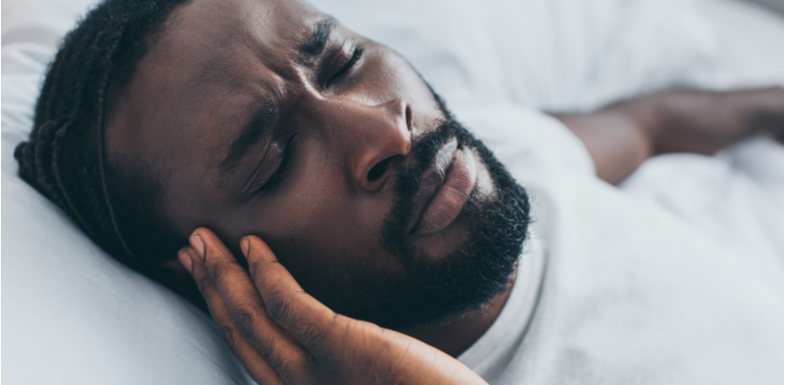Nothing is worse than a poor night of sleep… unless your poor night of sleep also comes with an early morning headache. While most people experience this one-two punch only occasionally, a sleep apnea headache is a real and regular occurrence for those who suffer from sleep disordered breathing. Here’s why sleep apnea and headaches are frequent companions.
What is sleep apnea?
Sleep apnea is a sleep disordered breathing condition that is easily recognized when you know what to look for. Apneas are pauses in breath that occur throughout the night, sometimes as often as 60 times an hour. The pause in breath lasts anywhere from a few seconds to half a minute.
The severity of sleep apnea is measured by the apnea-hypopnea index (AHI), a number that indicates how many times a sleeper stops breathing, and for how long each time. Mild sleep apnea has an AHI of five to 14 pauses in breath an hour, but severe sleep apnea sufferers may have more than 30 pauses each hour (with moderate sleep apnea in the middle).
The two main types of sleep apnea are:
- Obstructive sleep apnea: Obstructive sleep apnea is the most common form of sleep apnea. When sleeping, the muscles of the throat become so relaxed that they block or obstruct the airway.
- Central sleep apnea: This sleep apnea occurs as a malfunction of the central nervous system. The brain essentially forgets to send signals to breathe.
Some people suffer from a combination of both of these called complex sleep apnea, but this is very rare.
Common sleep apnea symptoms
During apneic events, the sleeper stops breathing for a period of time. They then wake with a gasping or choking intake of breath. They may not come fully awake, which is why a sleeper’s partner is often the person who first recognizes symptoms.
Other common symptoms of sleep apnea include:
- Daytime drowsiness
- Difficulty concentrating
- Snoring
- Dry mouth
- Increase in cavities (due to dry mouth)
And yes, sleep apnea headache is another common symptom.
Does sleep apnea cause headaches?
While research is limited when it comes to sleep apnea migraines, sleep apnea headache is a symptom that occurs in an estimated 50% of sleep apnea sufferers.
Headaches occur in part due to trapped waste in the lungs when they are not fully emptied. This waste is carbon dioxide, and it eventually makes its way into the blood through capillaries in the lungs. Once the blood is saturated with carbon dioxide (essentially a type of poison to the body), a headache can result.
Headaches that occur both in the morning and those that last all day may be a result of this carbon dioxide contracting the blood vessels. Vasoconstriction can cause headaches and, in extreme cases, stroke.
In addition to a headache that’s caused by poor air quality, many people who suffer from sleep apnea also grind their teeth. This condition (known as bruxism) can cause head pain as a direct result of tension and clenching in the jaw. Almost 25% of people with obstructive sleep apnea also grind their teeth at night. Whether sleep apnea comes before bruxism or vice versa is not well-known, but these two conditions are often comorbid and can also lead to morning headache.
Finally, sleep apnea headache may occur as a result of using a CPAP machine. CPAP machines with a pressure setting that is too high can cause morning headaches. This might also be compounded if the sleeper has a sinus infection or other issues in the sinus cavity that make them more sensitive to pressure.
What does a sleep apnea headache feel like?
A sleep apnea headache is generally felt on both sides of the head and occurs fairly predictably every morning. These headaches do not differ from a headache you might get from other causes, but the hallmark is that those with sleep apnea might get them every morning.
On the other hand, migraines may occur more frequently for people with sleep apnea, but they are not as regular. Migraine pain is very specific and usually occurs on just one side of the head. Additionally, migraine headaches generally come with other symptoms, like visual complications, nausea, and dizziness.
Both sleep apnea headache and migraine come with pain that can range from mild to severe.
How to get rid of sleep apnea headaches
In many cases, getting rid of sleep apnea headache starts with understanding the cause of your pain. If you suffer from poorly managed sleep apnea, the first step is to get a proper diagnosis, either with a sleep study or a high-quality at-home sleep apnea test.
Once you get a diagnosis and begin treatment, you may find your sleep apnea headaches disappear with a few deep breaths or a more structured breathing practice in the morning. This clears the lungs of residual carbon dioxide that may have pooled in them overnight. Couple these breaths with a big glass of water for healthy hydration to keep head pain at bay.
If you manage your sleep apnea with a CPAP machine and wake with frequent headaches, check to see that the pressure is properly set on your machine. It may take some adjusting to find the right balance.
For those who grind their teeth at night, or if a CPAP machine is not a good treatment option, a sleep apnea dental device may help. This device positions the jaw slightly open, with the lower jaw forward to keep your airway open and clear all night long. Many people find it easier to use a sleep apnea oral appliance, so compliance can be higher than with a CPAP machine.
AZ Dentist is a sleep apnea dentist with convenient locations across the Phoenix area. If you need help managing your sleep apnea to prevent sleep apnea headaches, get in touch today! We’re here to help.
